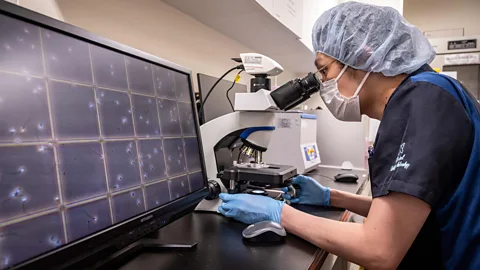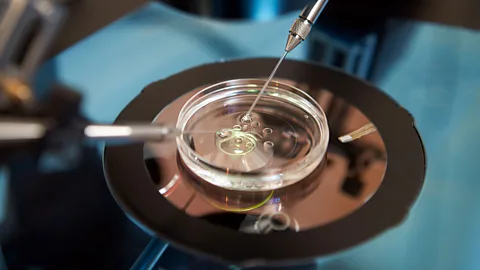Fertility Explained: How Men and Women Differ in Reproductive Health

Fertility is a fascinating and intricate topic, highlighting stark contrasts between male and female reproductive systems. While men have the capacity to produce sperm continuously throughout their lives, women are born with a limited number of eggs, facing a more defined reproductive window. Understanding these biological differences is key to making informed decisions about family planning, reproductive health, and the impact of age on fertility. Let’s explore the science behind fertility, how it changes over time, and the factors that influence it for both genders.
SDI Productions/Getty Images
Male Fertility: Continuous Reproduction Through Life
One of the most notable differences in fertility is that men remain fertile from puberty until the end of their lives. This ability is due to the process of spermatogenesis, which enables the continuous production of sperm cells.
How Sperm Is Produced
Spermatogenesis occurs in the testes and begins during puberty, where specialized cells divide and mature to form sperm. Remarkably, the male body produces around 1,500 sperm every second, amounting to 8 billion sperm over the course of a full production cycle, which lasts about 64 to 74 days. This regenerative process ensures a consistent supply of sperm throughout a man’s lifetime.
Sperm Viability and Fertilization
Once ejaculated, sperm can survive in the female reproductive tract for 2 to 3 days, creating a relatively short window for fertilization. However, the quality of sperm, including its motility (movement) and morphology (shape), plays a crucial role in the likelihood of successful conception.
The Impact of Age on Male Fertility
While men can produce sperm indefinitely, fertility does decline with age. After the age of 40 to 45 years, the following changes are commonly observed:
- Lower sperm count
- Reduced motility
- Higher rates of DNA fragmentation, which increases the risk of genetic abnormalities in offspring
These factors may lead to longer times to conceive, a higher risk of miscarriage, and an increased likelihood of developmental disorders such as autism or schizophrenia in children born to older fathers.
Female Fertility: A Limited Window for Reproduction
In contrast, women have a finite reproductive timeline, starting at puberty and ending with menopause. Women are born with a fixed number of eggs, which steadily decline in both quantity and quality over time.

ilona titova/Getty Images
Egg Supply and Ovarian Reserve
At birth, a female infant has around 1 million eggs (ovarian follicles). However, by puberty, only 300,000 eggs remain. Each menstrual cycle sees the maturation and release of just one egg through ovulation, with a total of 400 to 500 eggs being ovulated over a woman’s lifetime.

Global trends suggest that sperm counts have been steadily declining over the past five decades (Credit: Edward Berthelot/Getty Images)
Monthly Ovulation and Fertilization Window
During ovulation, an egg is released from the ovary and travels down the fallopian tube. Unlike sperm, which can survive for days, the egg remains viable for just 12 to 24 hours. If fertilization does not occur within this narrow timeframe, the egg disintegrates and is expelled during menstruation.
The Decline of Female Fertility with Age
- In the 20s: Fertility peaks, with a 25% chance of conception per cycle.
- After Age 30: The chances of conceiving naturally drop to 20% per cycle.
- By Age 40: The probability of conception decreases further to 5% per cycle.
- Menopause: Fertility ends entirely, typically between 45 and 55 years of age.
As women age, not only do the number of eggs decline, but their quality diminishes as well, leading to a higher risk of chromosomal abnormalities, miscarriages, and complications during pregnancy.
How Age Impacts Fertility Differently in Men and Women
While both men and women experience fertility declines with age, the timing and biological mechanisms are distinct.
Women’s Fertility Timeline
Women face a more abrupt fertility decline, with significant reductions in conception chances starting in their early 30s. By their mid-40s, achieving pregnancy without medical intervention becomes highly unlikely.
Men’s Fertility Timeline
In comparison, men experience a more gradual decline. Even though sperm production continues throughout life, the age-related deterioration in sperm quality can still affect fertility outcomes and the health of potential offspring.
Factors That Influence Fertility
Fertility is affected by a wide range of factors, including lifestyle choices, genetic predispositions, and underlying health conditions.

There is mounting evidence that pollution may be at least partly behind declining sperm quality and sperm counts (Credit: Yuichi Yamazaki/AFP/Getty Images)
Lifestyle Factors
- Weight:
Maintaining a healthy weight is critical for fertility. Women who are either overweight or underweight may experience hormonal imbalances that disrupt ovulation. Research shows that around 12% of female infertility cases are linked to weight issues. Similarly, obesity in men can lead to reduced testosterone levels and poor sperm quality. - Smoking and Alcohol:
Smoking damages eggs and sperm, reduces the effectiveness of fertility treatments, and increases miscarriage risk. It’s estimated that 13% of female infertility is related to smoking. Excessive alcohol consumption also negatively affects reproductive health in both genders.
Genetic Factors
- Egg and Sperm Quality:
Genetic mutations or inherited conditions can impair egg supply in women or sperm production in men, leading to infertility or an increased risk of passing on genetic disorders.
Health Conditions
- Polycystic Ovary Syndrome (PCOS):
A hormonal disorder affecting ovulation in women, often leading to infertility. - Endometriosis:
A condition where tissue similar to the uterine lining grows outside the uterus, causing pain and reducing fertility. - Varicocele:
In men, this condition involves enlarged veins in the scrotum, which can impair sperm production and quality.
Infertility: A Shared Responsibility
Infertility is often perceived as a predominantly female issue, but data reveals a more balanced picture. Statistics show that:
- 40% of infertility cases are due to female factors.
- 30% of cases are attributed to male factors.
- 20% involve both partners.
- 10% of cases remain unexplained.
This highlights the importance of evaluating both partners during fertility assessments to identify and address potential issues.
Modern Solutions for Overcoming Fertility Challenges
Advancements in reproductive technology have provided a range of options for couples struggling with infertility. Here are some of the most common treatments and procedures:
In Vitro Fertilization (IVF)
IVF involves fertilizing an egg outside the body and implanting the resulting embryo into the uterus. This method is widely used for various fertility issues, including advanced maternal age and unexplained infertility.

IVF treatment is offering hope to couples with fertility problems, but it is expensive and not available to everyone (Credit: Alamy)
Intracytoplasmic Sperm Injection (ICSI)
In cases of severe male infertility, ICSI is often employed. This procedure involves injecting a single sperm directly into an egg to facilitate fertilization.
Egg and Sperm Freezing
This option allows individuals to preserve their reproductive cells for future use, offering flexibility for those who wish to delay parenthood.
Hormonal Treatments and Medications
Hormone therapy can help regulate ovulation in women or boost sperm production in men, depending on the underlying issue.
Lifestyle and Dietary Changes
Improving overall health through balanced nutrition, regular exercise, and stress management can significantly enhance fertility in both genders.
Fertility Awareness and Family Planning
Understanding how fertility works can empower individuals to make informed decisions about when and how to start a family. Here are some practical steps to enhance fertility awareness:
- Consult a Specialist: If you’re planning to conceive later in life or suspect any reproductive issues, consult a fertility specialist for guidance.
- Track Ovulation: For women, tracking ovulation cycles can help identify the most fertile days of the month.
- Regular Health Check-Ups: Routine medical check-ups can help identify and address potential fertility issues early.
The Future of Fertility Science
Ongoing research and technological advancements continue to reshape the field of reproductive medicine. Innovations like artificial wombs, gene editing, and non-invasive fertility diagnostics promise to revolutionize how we approach fertility challenges.
Additionally, the growing emphasis on environmental sustainability is driving efforts to develop eco-friendly fertility treatments that minimize waste and energy consumption.
Conclusion: Understanding Fertility to Shape a Better Future
The biological differences in male and female fertility highlight the importance of early awareness, proactive measures, and a holistic approach to reproductive health. While men enjoy the advantage of lifelong sperm production, women face a more time-sensitive fertility journey, making informed family planning decisions essential.
With modern fertility treatments, improved lifestyle habits, and a deeper understanding of reproductive science, individuals and couples have more options than ever to navigate their fertility journeys successfully. Whether through natural conception or assisted reproductive technologies, the dream of parenthood remains achievable for many.
Featured Image Credit: Getty Images,Alamy







